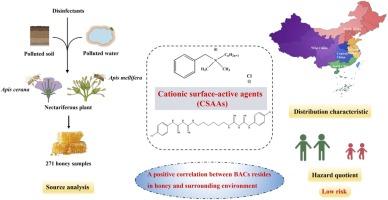中国蜂蜜中阳离子表面活性剂的分布及人体健康风险评估
IF 11.3
1区 环境科学与生态学
Q1 ENGINEERING, ENVIRONMENTAL
引用次数: 0
摘要
阳离子表面活性剂(CSAAs)可以在环境水中持续存在,被蜜蜂摄入,并污染蜂蜜。CSAAs在蜂蜜中的残留尚不清楚。本研究采用超高效液相色谱-三重四极杆串联质谱法测定了271份中国蜂蜜样品中5种CSAAs的残留水平。苯扎氯铵- c12 (BAC-C12)、BAC-C14、BAC-C16、氯己定(CHG)和4-氯苯胺残留量分别为0.0098 ~ 2.1468、0.0061 ~ 1.7492、0.0012 ~ 1.6305、0.1576 ~ 0.8401和0.0019 ~ 0.0234 μg kg-1。红枣、杂交藤、野花、羊草和龙眼蜂蜜中CHG和BAC的检测率均为100%;在所有CSAAs中,团蜜的检出率最低。BAC- c16在华北、华中地区的残留水平最高。华北地区和华东地区CHG的检出率分别为91.38%和100%。蜜蜂蜂蜜中BAC-C12含量显著高于蜜蜂蜂蜜(P <;0.001)。危害商和危害指数值表明,蜂蜜中的CSAAs残留不会造成健康风险。相关分析表明,蜂蜜中BACs与周围环境呈正相关。研究结果表明,持续监测蜂蜜中的CSAAs是必要的,以确保其供人类食用的安全性,同时也可以作为评估特定地区环境污染的有效矩阵。本文章由计算机程序翻译,如有差异,请以英文原文为准。

Assessing the distribution and human health risks of cationic surface-active agents in honey from China
Cationic surface-active agents (CSAAs) can persist in ambient water, be ingested by bees, and contaminate honey. Residues of CSAAs in honey remains unknown. This study measured the residual levels of five CSAAs in 271 honey samples from China using ultrahigh-performance liquid chromatography coupled with triple-quadrupole tandem mass spectrometry. Residual benzalkonium chloride-C12 (BAC-C12), BAC-C14, BAC-C16, chlorhexidine (CHG), and 4-chloraniline levels were 0.0098–2.1468, 0.0061–1.7492, 0.0012–1.6305, 0.1576–0.8401, and 0.0019–0.0234 μg kg−1, respectively. CHG and all BAC were detected in 100 % of Z. jujuba, V. negundo var. heterophylla, wildflower, L. chinensis, and D. longan Lour honey; T. tuan honey had the lowest detection rate of any CSAAs. BAC-C16 had the highest residual level among all BAC tested in Central, North China. CHG levels were detected in 91.38 % of samples in North China and 100 % in East China. BAC-C12 was significantly higher in A. cerana versus A. mellifera honey (P < 0.001). Hazard quotient and Hazard index values indicate that CSAAs residuals in honey do not pose a health risk. Correlation analysis revealed a positive correlation between BACs resides in honey and surrounding environment. The findings suggest that continuous monitoring of CSAAs in honey is imperative to ensure its safety for human consumption, while also serving as an effective matrix to assess the environmental pollution of a given region.
求助全文
通过发布文献求助,成功后即可免费获取论文全文。
去求助
来源期刊

Journal of Hazardous Materials
工程技术-工程:环境
CiteScore
25.40
自引率
5.90%
发文量
3059
审稿时长
58 days
期刊介绍:
The Journal of Hazardous Materials serves as a global platform for promoting cutting-edge research in the field of Environmental Science and Engineering. Our publication features a wide range of articles, including full-length research papers, review articles, and perspectives, with the aim of enhancing our understanding of the dangers and risks associated with various materials concerning public health and the environment. It is important to note that the term "environmental contaminants" refers specifically to substances that pose hazardous effects through contamination, while excluding those that do not have such impacts on the environment or human health. Moreover, we emphasize the distinction between wastes and hazardous materials in order to provide further clarity on the scope of the journal. We have a keen interest in exploring specific compounds and microbial agents that have adverse effects on the environment.
 求助内容:
求助内容: 应助结果提醒方式:
应助结果提醒方式:


